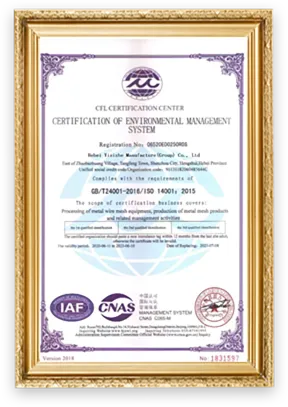10 月 . 18, 2024 10:21 Back to list
Innovative Applications and Benefits of Using Binder Wire in Various Industries
Understanding Binder Wire An Essential Tool in Various Industries
In the world of construction, manufacturing, and agricultural sectors, binder wire is an often-overlooked yet critical component that plays a significant role in diverse applications. Understanding its characteristics, uses, and advantages can provide insights into its importance across various industries.
What is Binder Wire?
Binder wire, often referred to as fencing wire or binding wire, is a type of wire used primarily for tying and binding different materials together. Typically made from galvanized steel, although it can also be found in stainless steel and other alloys, binder wire is known for its durability, flexibility, and resistance to rust. These properties make it suitable for outdoor as well as indoor uses.
Types of Binder Wire
Binder wire comes in various gauges, lengths, and coatings to suit different needs. The most common types include
1. Galvanized Steel Binder Wire This type is coated with a layer of zinc to prevent rusting, making it ideal for outdoor applications such as gardening, fencing, and agricultural uses.
2. Stainless Steel Binder Wire Known for its superior corrosion resistance, stainless steel binder wire is often used in environments where moisture is prevalent or where hygiene is a critical concern, such as in the food and medical industries.
3. Plastic Coated Binder Wire This variety is wrapped in plastic, providing additional protection against corrosion and making it aesthetically pleasing for home and garden projects.
Applications of Binder Wire
1. Construction In the construction industry, binder wire is used for binding rebar together, providing structural integrity to concrete structures. It can also be employed in securing various building materials during transportation or storage.
binder wire

2. Agriculture Farmers widely use binder wire for tying plants to stakes or trellises. It helps maintain plant structure and support, promoting healthy growth. Additionally, it is helpful in fencing to keep livestock secure.
3. Crafting and DIY Projects Many artisans and DIY enthusiasts utilize binder wire in their creative projects. Its flexibility allows for easy manipulation, making it perfect for sculptures, floral arrangements, and other craftworks.
4. Packaging and Shipping Binder wire is also commonly used in packaging to secure boxes and bundles, ensuring items remain intact during transport. It is an economical solution for various packaging needs.
Advantages of Using Binder Wire
The benefits of using binder wire are numerous
1. Cost-Effective Binder wire is relatively inexpensive, allowing businesses and individuals to save on materials without sacrificing quality or performance.
2. Versatility Its ability to be used in diverse applications makes it an invaluable tool across many sectors.
3. Strength and Durability With its robust construction, binder wire can withstand various environmental conditions, ensuring long-lasting use.
4. Ease of Use Binder wire is lightweight and easy to manipulate, enabling quick and efficient binding of materials.
Conclusion
While often overlooked, binder wire serves as a vital tool in multiple industries, contributing to the efficiency and effectiveness of various processes. Whether in construction, agriculture, crafting, or shipping, understanding the essential role of binder wire can help optimize operations and enhance creativity. As the demand for reliable and versatile materials continues to grow, binder wire remains a fundamental asset in the toolkit of professionals and hobbyists alike. Its potential is as vast as its applications, ensuring that it will remain an essential resource for years to come.
-
Secure Your Roof with Quality Roofing Nails
NewsNov.04,2024
-
Secure Your Property with Quality Field Fencing
NewsNov.04,2024
-
Enhance Your Space with Quality Mesh Fencing
NewsNov.04,2024
-
Discover the Versatility of Iron Wire for Your Projects
NewsNov.04,2024
-
Discover the Versatility of Common Nails for Your Projects
NewsNov.04,2024
-
Discover Quality Hydraulic Fittings for Your Applications
NewsNov.04,2024









